Xunantunich
 Xunantunich (pronounced shoo-NAHN-too-nich) is a Mayan archaeological site in western Belize, about 80 miles west of Belize City in the Cayo District atop a ridge above the Mopan River. The Mayan name means “Stone Woman”.
Xunantunich (pronounced shoo-NAHN-too-nich) is a Mayan archaeological site in western Belize, about 80 miles west of Belize City in the Cayo District atop a ridge above the Mopan River. The Mayan name means “Stone Woman”.
Getting to Xunantunich was easy enough for us this morning. We ‘commissioned’ our host John to drive us to the entrance gate. After passing through the small village of San Jose Succotz, we crossed the Mopan River via a hand-cranked ferry. This was a really neat experience, especially having an enthusiastic boat captain putting his all in to cranking the wooden shuttle along a thick rope 80 feet across the river. Then it was a mile uphill trudge to Xunantunich, which in the Mayan language means “maiden of the rock” or “stone woman”. John, our driver, dropped us off in the midst of thick mist that secluded the temples and forest from the outside world, or so it seemed. At 8 am, very few people were exploring the ruins, so we pretty much had the grounds to ourselves and the machine gun-toting security guards. It was fascinating to watch the site unfold as the weather changed, sunlight and clouds giving new depth to character and expanse of the rock remnants. One of the tallest Mayan ruins found within Belize stands here at 133 feet tall, providing panoramic views of the hilly Cayo District (situated a mere 2 miles from the Guatemala border) and an impressive view of the entire river valley. Also existing are well-preserved sun god and ancestral masks that decorate the sculptured west and east friez. There are six major plazas and more than 25 temples and palaces to educate the hundreds (sometimes thousands) of daily tourists that flow through this popular Archaeological Reserve.
Here is a little history of the Maya civilization as I gathered from the various signs and guided stories at Xunantunich:
Archaeologists believe that Xunantunich, like many other Maya sites, was an ancient city. Xunantunich was not a large city and probably had a population of 7000 – 10,000 people living within a radius of 3 km from the site centre.
The earliest known Maya communities in Belize were settled around 1200 BC. Archaeologists believe that these first Maya people likely immigrated into this area from Western Guatemala or from the area around Southern Chiapos in Mexico. The early Maya immigrants predominantly relied on agriculture for subsistence and were adept in the production of pottery. In Belize the earliest known Maya villages include Cahal Pech and Blackman Eddy in the Cayo District, and Cuello and Colha in Orange Walk. As these early settlements developed, their inhabitants began to participate in long-distance trade, craft specialization, and the construction of special function architecture. The ancient Maya were a pre-industrial urban agricultural society with the technology based on tools and implements of stone. To support their economy and the growing populations practice of intensive and extensive agriculture, they grew such crops as maize, beans, squash, chili peppers, and many other tropical plants, and added to their subsistence with hunting, fishing and the consumption of domesticated dogs and turkeys.
They practiced a complex religion that combined the worship of nature gods and deified ancestors with shamanistic magic. Their rulers were a literate, hereditary nobility who mediated disputes, led in warfare and interceded with the Gods. These rulers married amongst themselves, fought wars with each other, and fostered the distinctive and sophisticated art styles which we identify with Maya civilization.
Communication with other groups led to the exchange of ideas, technologies, and shared ideology. During the Middle Pre-classic period (300 BC to AD 300), Cahal Pech and other communities increased in size, and they began to construct monumental architecture. , and there are more obvious differences in the social status of some people in the population. By the end of the Pre-classic period, what were once small villages had become thriving towns and precocious cities. It is at this time that Maya civilization became fully established.
After our exploration of Xunantunich, we found we had probably just enough time to walk the mile back to the ferry, catch a local bus in to San Ignacio, fetch our bags from the Guesthouse and catch our 1pm bus back to Belize City. Already at 11am, the heat was muggy and intense. I, in an attempt to save our energy and escape the fiery solar rays, stuck out my thumb trying to catch a ride at least back to the ferry. As luck would have it, within a few minutes we were bustling along in an air-conditioned private tour van that shuttled us all the way back in to town. Bonus! This gave us plenty of time to fetch our bags and enjoy a leisurely lunch.
What an amazing tour we’ve had of the region! The 2 hour express bus ride back to Belize City was delightful, with room enough to have seats of our own for most of the entire journey. The music was typical Latin American Reggaetón with heavy beats and a lead-foot driver. Ola! We arrived back in the city with plenty of time to catch our 6pm water taxi back to San Pedro. I’m so happy that we took a few days to explore the mainland and discover a bit about the Belizean and Mayan culture.
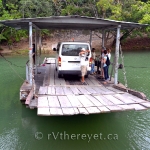
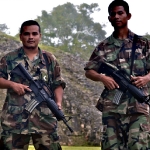
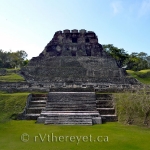
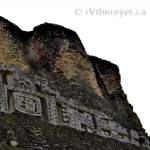
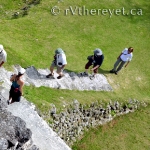
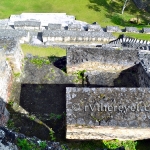
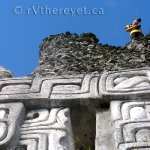
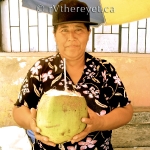

When we meet again ask me about the 1st Caravan and a logger from British Honduras.